
3 Advanced Marketo Lead Nurturing Tactics For Revenue-Focused B2B Marketers
Looking to elevate your nurture program to be a top driver of qualified demand? Check out these next-level best practices.
Did you know that 96% of visitors who come to B2B website are not ready to buy yet?
Here’s what this means for today’s revenue-focused marketer: no matter how slick, informative, and engaging your website is, it’s still not enough to fully educate prospects. This is especially true for B2B marketers who are selling a complex solution—people just need more time and more information to actually arrive at a purchase decision.
That’s why I love lead nurturing tactics. There may be a lot of latent demand in your database, but people aren’t always able to connect the dots between their needs and your solution right away. A solid lead nurturing program helps you stay top-of-mind for when your prospects are ready to buy.
In my 10 years as a marketer, I’ve seen it become a top driver of qualified demand for me, and I’m confident it has the potential to be the same for you. In this blog, I’m going to share my top 3 advanced lead nurturing tactics that will help you identify latent demand in your database and convert that into pipeline. But first, let’s quickly review some B2B Lead Nurturing Tactics to make sure you have a strong foundation.
The foundations of a high-performing B2B lead nurture program
Here are my top tips for getting started with a lead nurture program. (If you already have a B2B lead nurture program, you can skip straight to the next section.) The ultimate goal is to reduce the friction your buyer experiences in their journey by delivering them the right content at the right time. By educating your leads with relevant content, you’ll turn them into MQLs faster.
1. Start small: B2B lead nurture programs aren’t built in a day
Building a B2B lead nurture from scratch can be intimidating, and many marketers are reluctant to get started when they consider how complex nurture programs can get. But, as a mentor of mine used to always say, you don’t need to boil the ocean.
My advice: Just do it. Start with a really simple program. It could be two or three or four emails. If you can learn from early results as you build up your nurture program, you can optimize as you go, and end up with a far more polished result than if you were to start by biting off more than you can chew. You have nothing to be afraid of. You can really only get better and better at it!
2. Look for ways to repurpose existing content
Another common objection to starting a nurture program: “But I don’t have the time or resources to create a bunch of new B2B content.”
Here’s the thing—many people don’t realize how much content they’re sitting on. Maybe it’s buried away, or maybe it’s unconventional content types you wouldn’t normally think about (e.g. your reviews on a review site, or 3rd party pieces.) That’s why I’d recommend starting with a quick content audit to uncover some gems that might be right under your nose.
Here are some ideas for content types and sources you can draw from:
- Blog posts
- Long web pages
- Videos
- Infographics
- eBooks
- Whitepapers
- Third-party content
- Research reports
- Reviews
Once you’ve gathered a handful of content assets you can repurpose for your nurture program, you’ll likely realize it’s less daunting than you thought to get started.
3. Plan out your engagement programs and streams
Next you have to think about how you want to segment leads to ensure you’re delivering relevant and valuable content to the right people.
Here are the 5 most common ways marketers segment their lead nurtures:
- Product lines
- Personas
- Topics
- Funnel stage
- Industry
There are many effective ways to organize your nurture program. Ultimately it comes down to a decision as to the best way to deliver valuable, informative content to your leads.
3. Plan out your engagement programs and streams
Next you have to think about how you want to segment leads to ensure you’re delivering relevant and valuable content to the right people.
Here are the 5 most common ways marketers segment their lead nurtures:
- Product lines
- Personas
- Topics
- Funnel stage
- Industry
There are many effective ways to organize your nurture program. Ultimately it comes down to a decision as to the best way to deliver valuable, informative content to your leads.
Next-level lead nurture best practices
Here’s a startling fact: 77% of marketers state that their lead nurture programs need improvement, or are average at best, according to research by DemandGen.
That’s why you need to get creative to ensure that your nurture program is truly working for you.
Here are my tried-and-true secrets of success that will help you join the ranks of those 23% of marketers who are confident their nurture program is effectively generating qualified demand.
Advanced tactic #1: Accelerate your nurture’s pace to match your buyer’s level of interest, and use skip logic to prevent redundant emails
In your lead database, you’re always going to have a mix of people who are actively looking to make a purchase, and others who are casually keeping their eyes peeled for when the time is right. To give both of these types of buyers what they want, why not adjust the speed of your nurture to match their appetitive, based on the behavioural signals they’re giving you?
Think about the last time you were ready to purchase something. If you’re like most people, you probably started on Google, with a concentrated burst of attention and energy. Maybe you bounced around from vendor websites to review sites to YouTube product unboxings.
B2B buyer behaviour is much the same. When buyers have a moment to research, they want to go deep and consume multiple assets in a single session. So when your buyers give you the signals that they’re ready, you want to serve them the content they’re after at their pace.
How it’s done
To accommodate your fast moving buyers as well as those whose interest is simmering on the back burner, I recommend setting up multiple streams in Marketo that run on different cadences.
The first step is to set up streams of identical content. You can use as many as you want, but in this example we have three: slow lane, medium lane, and a fast lane.
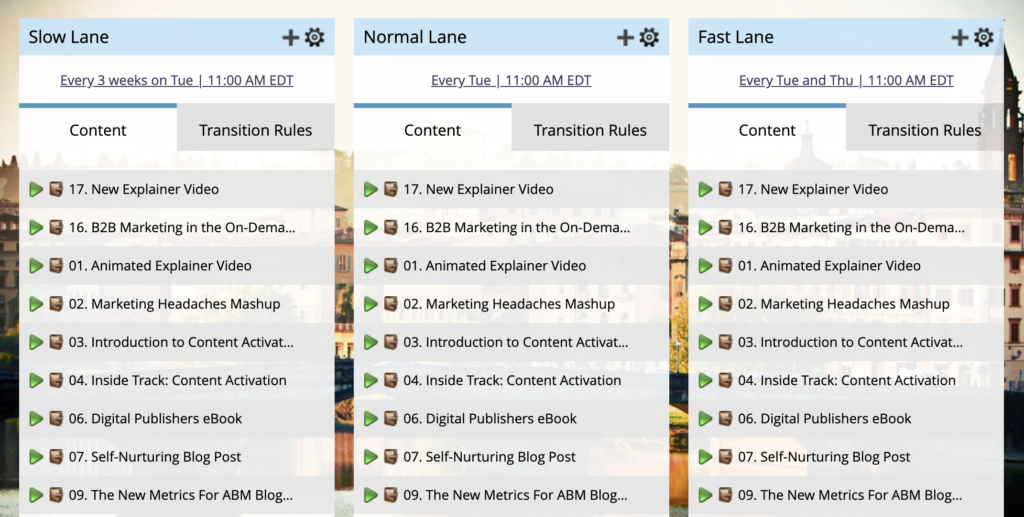
For example, your medium lane could be sent out once per week, your accelerated stream could get sent out twice per week, and your slow lane might be sent once every three weeks. There’s no magic number for frequency. It all depends on your customers and how they like to engage.
The best way to pick a cadence is to have a look at your data on leads that have closed, and see how many engagements per week they have—for example, how many times they hit your site or opened an email. Their maximum and minimum ranges should serve as a helpful guide for the frequency of touchpoints your buyers want.
In order to place the right person in the right stream you’ll want to set up a mechanism to listen for engagement and move the person to the appropriate stream. In the example below we’ve used a Smart Campaign that references three different smart lists. Each smart lists looks at the data coming in from PathFactory around how much time each person has spent with your content to determine which person should be in which lane.
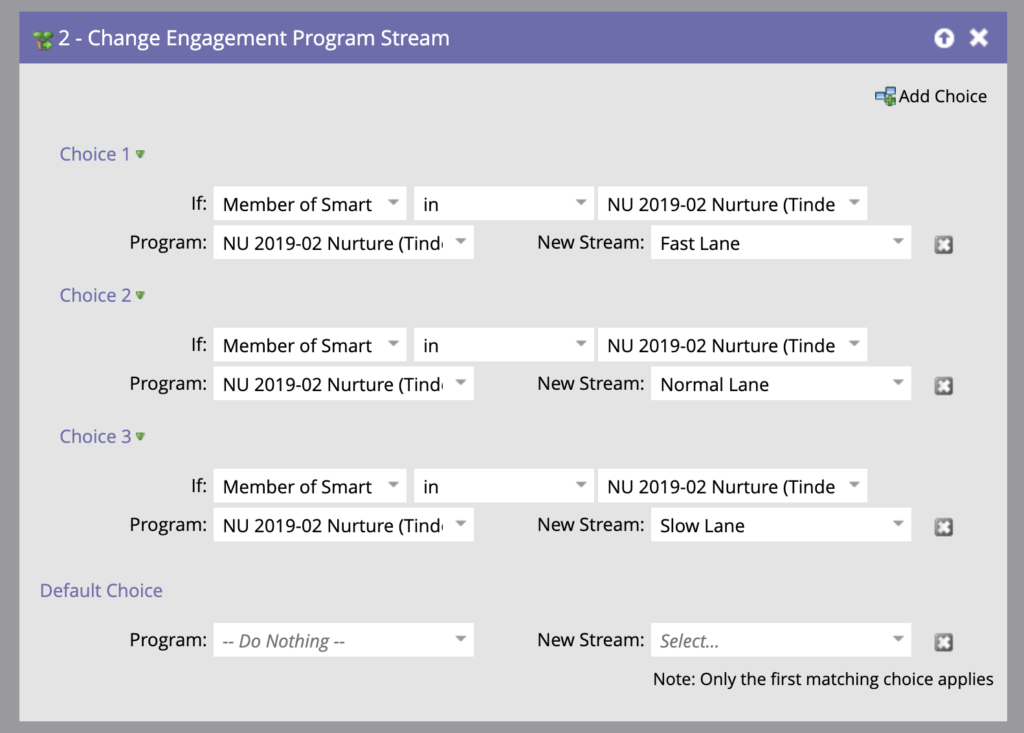
The next step is to set up skip logic so that your buyers don’t receive an email pointing them to a piece of content they’ve already consumed. To make this work, we’ll be taking advantage of a little known feature in Marketo. Nurture emails will not be sent to anyone who is a member of the program an email sit inside of (as long as you add the email to the stream as a program and not an email). Neat huh?
First, start by nesting each of your nurture emails in a program that itself is nested inside your engagement program (we’ll call this a “sub-program”). Then when adding each email to your stream select the sub-program and a simple smart campaign inside the sub-program which simply sends the email.
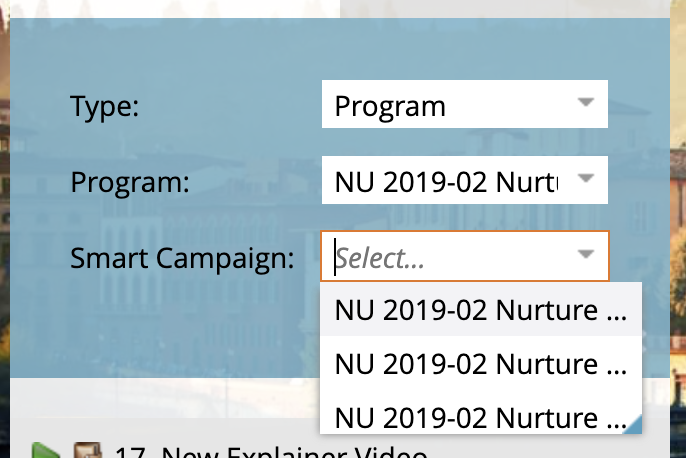
Finally, you’ll want to add a Smart Campaign within each sub-program that makes a person a member of the sub-program if they’ve engaged with the content asset that particular email points to. In this way you can exclude people who have interacted with a piece of content from receiving a redundant content offer.
This will lead to a nurture program that is binge-friendly, and tailored to a person’s behavior. If they’re highly engaged, they’ll get emails more often, if not they’ll get them less often. If they binge ahead to content you had saved for later, you can automatically skip send them those emails. Beautiful, right!?
Advanced tactic #2: Personalize your email copy content to resonate with your specific buyers
Personalizing your email copy is a surefire way to increase response rates.
It’s just like when I try to feed my son broccoli with his dinner—he spits it right out. But when I mix his veggies into something he loves, like mac & cheese, he absolutely devours it.
Your marketing messages are like broccoli. And as a marketer, it’s your job to cook up some mac & cheese (in the form of interesting storytelling angles) so it’s appealing to your prospects.
Instead of serving up the same eBook to your audience in the same old way, why not write multiple versions of the email copy designed to be delicious to different audiences?
How it’s done
You can use Marketo dynamic email content to personalize the same email for different audiences. You’ll power these with underlying segmentations in your Marketo database so be sure to set those up first. Remember, if you draw out the value that specific audiences will get from an asset in your copy, you’ll get a far better response rate. Demographics and firmographics are standard ways to do this.
Here are 6 things you can personalize inside a Marketo email:
- Subject line
- Sender’s name
- Hero banner
- Email copy
- Call-to-action links and text
- Additional content recommendations that show up in the email
This approach has worked really well for me in the past. For example, in one of our nurture emails at PathFactory, we sent out the same asset to 3 different personas we target a lot in our marketing—demand gen, marketing ops, and content marketers, as you can see below. But we modified the subject line and body copy to call out those specific roles. This required pretty minimal effort, but we saw a 2x lift in our response rate.
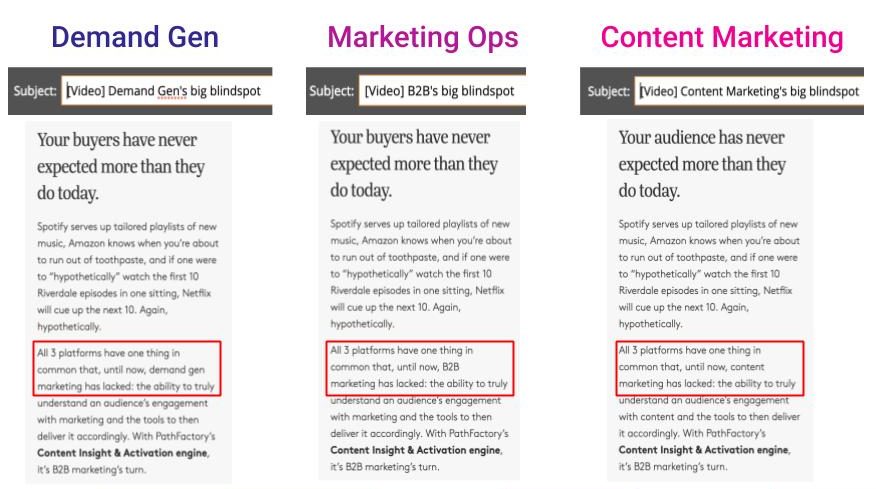
But sometimes you don’t have the data you need to personalize an email the way you want. Do you know what the person’s job title is? How about if they’re more interested in Product A or Product B? Do they do forensic or managerial accounting? A great place to start is making sure you’re appending data to your leads, contacts and accounting. Leading provider RingLead was a contributor on a recent webinar we did on this topic and provides 3rd party demographic, firmographic, technographic, and intent data.
In addition, if you use PathFactory you can gather better 1st party data on what people are most interested in in your marketing. Things like the topics they’ve spent the most time on and the products or solutions they’re most likely to buy. With the best 1st party and 3rd party data in hand you’ll have everything you need to personalize your nurture in any way you can imagine.
Advanced tactic #3: Use add-ons and integrations to elevate your streams
Marketo has a lot of great features out-of-the box. But if you want to truly invest in a higher performing nurture program, there are many add-ons and integrations that can open up new possibilities. We’re going to share how two of these—ContentAI and PathFactory—can supercharge your nurture program.
How it’s done
ContentAI is an add-on by Marketo that automatically populates recommendations into your emails with popular content. While your typical Marketo nurture email will have a primary call-to-action pointing to a single content asset, using ContentAI you can add an additional “other things you might be interested in” row of content at the bottom of your nurture emails.
PathFactory allows you to send your nurture clicks to Content Tracks. You can set up Content Tracks that have all of the assets in a nurture program bundled up so that prospects can “binge ahead” and consume more than just one asset per email they click through on.
Think about it. If you’re like most B2B marketers, you’re only getting a 2-4% click rate on your nurture emails. The chances of people clicking through on multiple emails in your nurture program is very low. So if you’re trying to walk your audience through a series of 6, 10, 12 or more assets, you need a way for them to binge ahead or go back and see what they missed–in the moment. Using the skip logic I outlined earlier, you can make sure they don’t get emails if they’ve spent meaningful time with the asset the email points to.
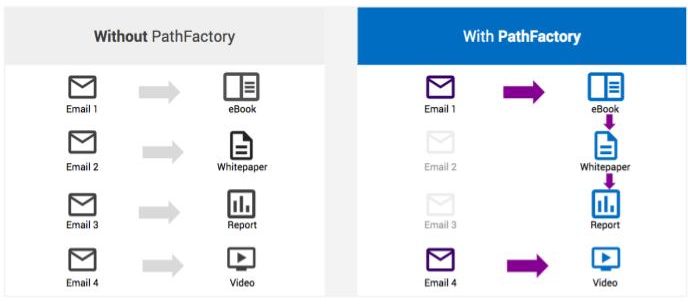
You can also use PathFactory content consumption data as triggers to skip to and from the fast, medium, and slow lanes mentioned in tip #1, and as a more accurate way to score and qualify leads. Think about it this way: if one prospect clicks on an eBook and spends 3 seconds on it, and another prospect clicks and reads it for 2 minutes and 47 seconds, shouldn’t your lead scoring reflect that difference in engagement?
Mervyn Alamgir, former Sr. Director of Marketing at TIBCO, used this approach, leveraging PathFactory content consumption data to score leads instead of relying on clicks and downloads. By basing lead scores on actual content consumption, he was able to create an impressive lift in his funnel performance. (Read more about how Mervyn pulled this off here.)
Now it’s your turn
Now that you’re equipped with both the foundational knowledge, and some next-level tactics, it’s time to start applying this to your own Marketo lead nurture program.
One final tip: remember your nurture is a living, breathing program. It’s important to constantly keep reporting on results, and learning as you go, and optimizing over time.
With the right mix of technology, process, and tactics, I hope you’ll get your hands dirty and build a spectacular nurture program that drives qualified demand for your organization.
Looking for a more detailed view at how to set up these advanced nurture techniques? Check out the recorded webinar below to see Chris Vandermarel from PathFactory, Amanda Thomas from Etumos, and John Kosturos from RingLead take a deep dive into advanced lead nurturing.
Enable Buyers with a Next-Level Marketo Nurture Program from PathFactory on Vimeo.
</div class>
